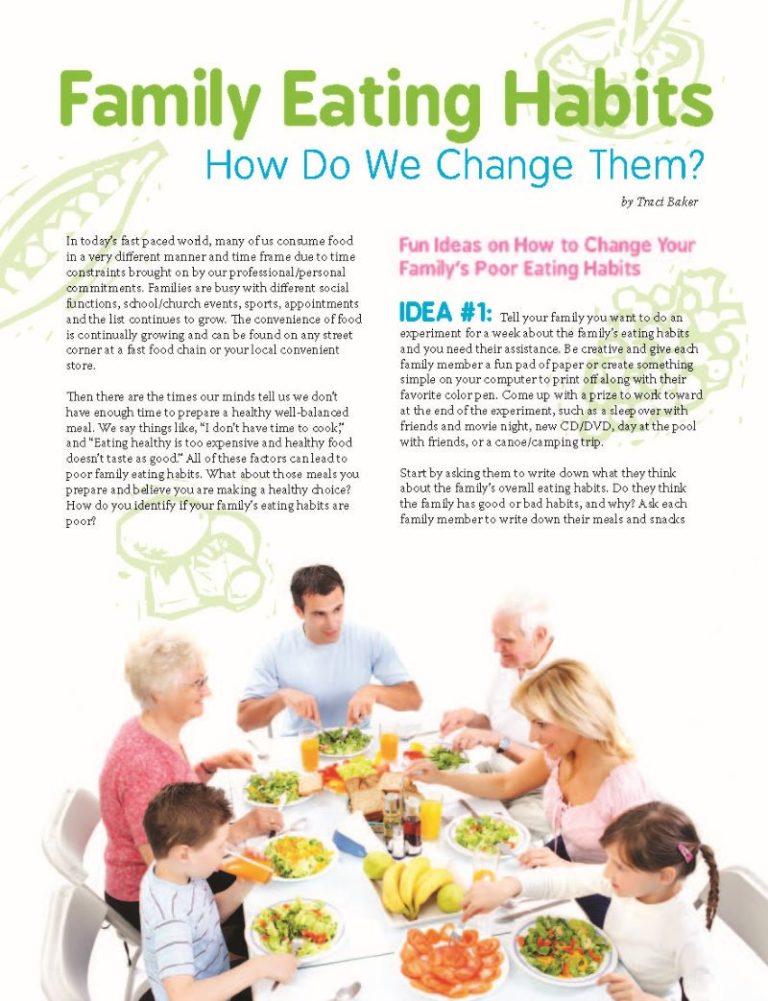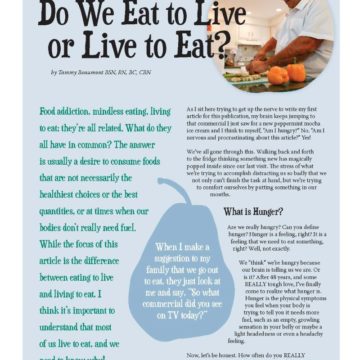Family Eating Habits – How Do We Change Them?


by Traci Baker
Summer 2011
In today’s fast paced world, many of us consume food in a very different manner and time frame due to time constraints brought on by our professional/personal commitments. Families are busy with different social functions, school/church events, sports, appointments and the list continues to grow. The convenience of food is continually growing and can be found on any street corner at a fast food chain or your local convenient store.
Then there are the times our minds tell us we don’t have enough time to prepare a healthy well-balanced meal. We say things like, “I don’t have time to cook,” and “Eating healthy is too expensive and healthy food doesn’t taste as good.” All of these factors can lead to poor family eating habits. What about those meals you prepare and believe you are making a healthy choice? How do you identify if your family’s eating habits are poor?
Fun Ideas on How to Change Your Family’s Poor Eating Habits
IDEA#1: Tell your family you want to do an experiment for a week about the family’s eating habits and you need their assistance. Be creative and give each family member a fun pad of paper or create something simple on your computer to print off along with their favorite color pen. Come up with a prize to work toward at the end of the experiment, such as a sleepover with friends and movie night, new CD/DVD, day at the pool with friends, or a canoe/camping trip.
Start by asking them to write down what they think about the family’s overall eating habits. Do they think the family has good or bad habits, and why? Ask each family member to write down their meals and snacks throughout the next week, the environment while eating (in the car, in front of the TV, standing at the counter, cleaning my plate because mom told me to) and what they do after each meal or snack (took a nap, walked the dog, played basketball, etc.).
At the end of the week, everyone will pass their entries to another family member for review. The goal is to highlight any repeated poor eating habits within the week. Here are some red flags to look for:
- Eating a limited variety of foods
- Indulging in too many foods like soft drinks, doughnuts, chips, candy or ice cream
- Not including all food groups such as vegetables
- Skipping breakfast
Ask everyone to give feedback on any items they highlighted and why they identified those as poor habits, then what a healthier choice would be.
IDEA #2: As a family, make a list of healthy meal/snack choices and post the list in a visible space for everyone to see. Then, make a list of all the recognized poor eating habits and ideas on how to change those to healthy eating habits. Decide together which family members deserve recognition and earn prizes on things such as:
- Identifying the poorest eating habits
- Providing healthier choices
- Creative ways to change those habits
At the end of the week, ask each family member the same question you did before the experiment started. Do they think the family has good or bad habits, and why? Then compare both answers.
Create a plan of action on how to replace the poor eating habits and what other changes will help promote healthy eating habits. Make this a fun project by including all family members and assigning tasks they enjoy. For example, purchase a bright colored poster board/trifold science board and create a title that fits your family. Make it visual by cutting out pictures of healthy foods, asking someone to be creative and decorate the board, create a healthy food list, list new habits to promote change and keep it visible in the kitchen as a reminder for the family.
Sample Changes to Help You Get Started
Here is a list to help get you started on some changes to promote healthy eating habits:
- Keep only healthy food options in your home. Have a family participation session to “purge the pantry” and remove all items not on your healthy list.
- Pick a specific time frame each night and agree to designate this as “family dinner time” with no interruptions.
- Make it a habit to sit together at a kitchen or patio table to encourage the importance of doing this together as a family.
- Slow down – it takes our minds 20 minutes to catch up with our stomachs. Practice putting your fork down between bites to force yourself to eat at a more leisurely pace. Engage in conversation as another way to slow your pace of eating.
- Stop eating when you feel full. The “clean your plate” mentality will lead to extra unnecessary calories in your body.
Ask each person to pick a day of the week and create a healthy meal plan and then help by preparing the meal. Make it fun by adding a theme, (Mexican, American, Italian, etc.) researching the Internet for healthy recipes or a specific color and use paper/plastic (cups, utensils, plates, napkins) to set the table.
Be creative, have fun and step out of your comfort zone while tasting new healthy food items. By encouraging your family to stay involved and repeating these behaviors, their healthy eating will become a daily habit!
About the Author:
Traci Baker is a professional in the field of bariatrics at the IU Health Bariatric & Medical Weight Loss. She is also the president of Bariatric Life Coach Association, LLC, where she works as a certified life coach specializing in working with all weight-loss patients. She is a support group leader, patient advocate and a member of the OAC.
by Sarah Muntel, RD Spring 2024 Spring has sprung, bringing sunnier and warmer days! For many, this…
Read Articleby Robyn Pashby, PhD Winter 2024 “No one is ever going to date you if you don’t…
Read Articleby Michelle “Shelly” Vicari Winter 2024 Winter has arrived! Don’t allow the chilly and damp weather to…
Read Article









